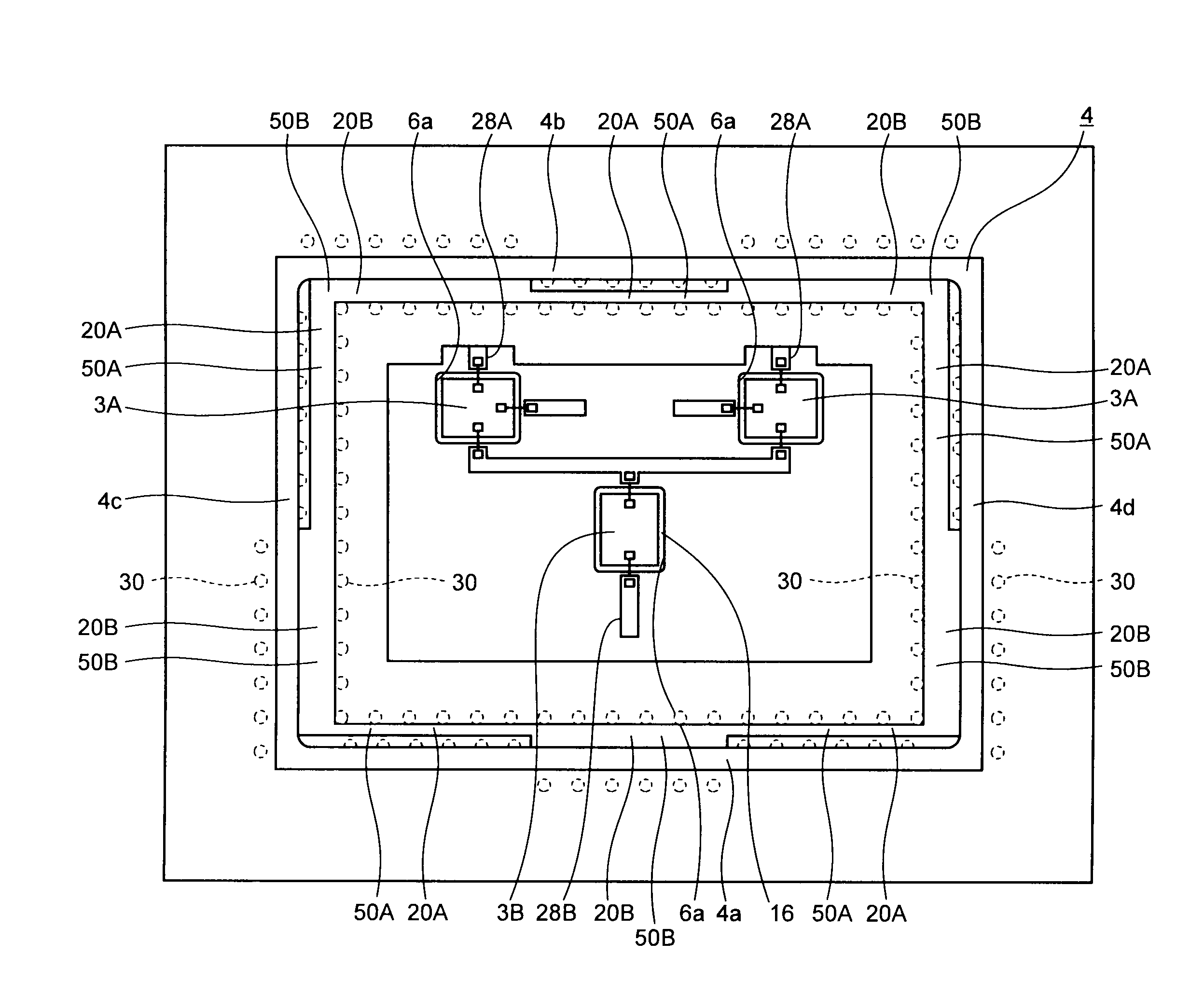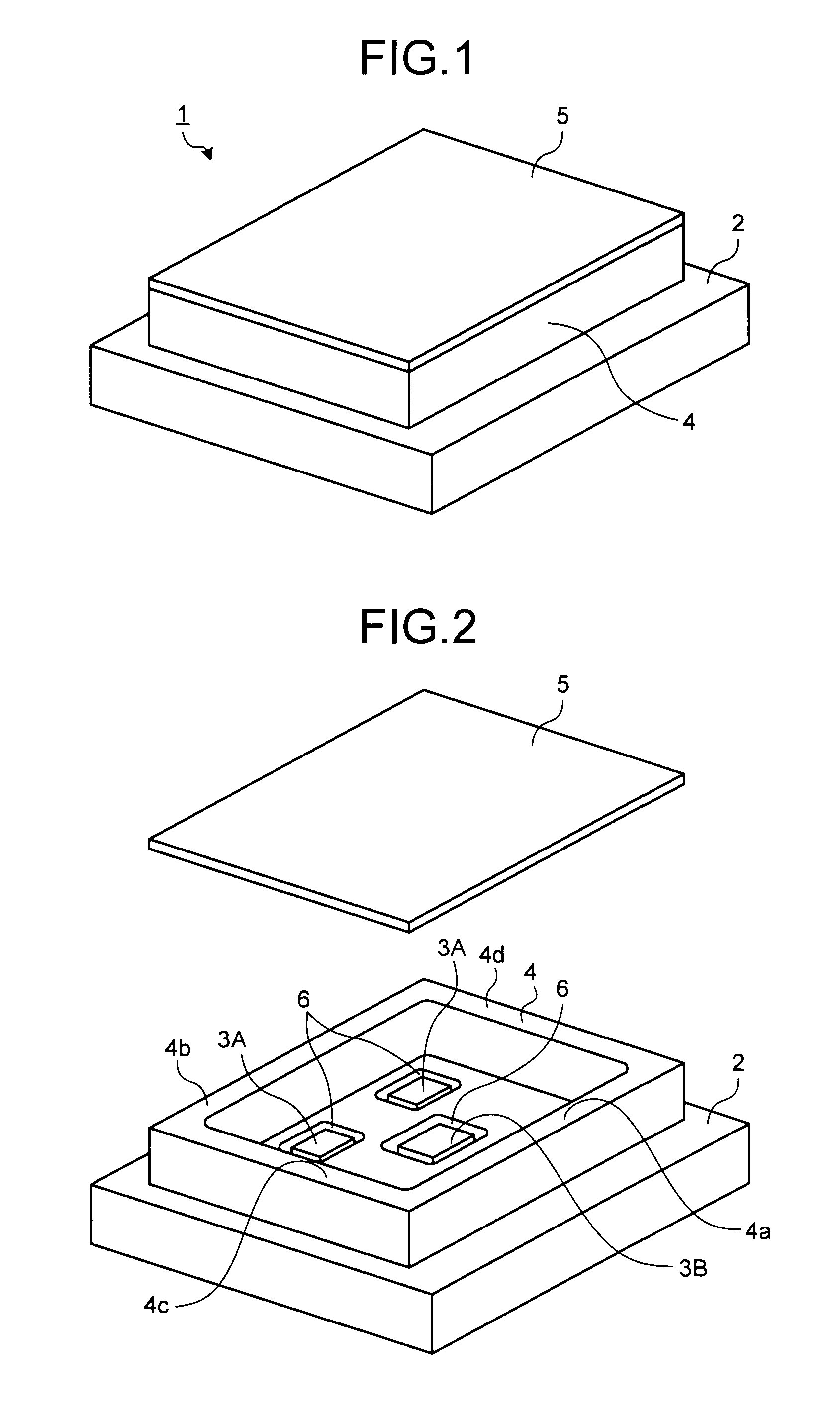Multilayer dielectric substrate and semiconductor package
a technology of dielectric substrate and semiconductor, applied in the direction of basic electric elements, resonators, semiconductor devices, etc., can solve the problems of unstable operation of semiconductor devices within the cavity, unstable characteristics of transmission lines, and difficulty in setting, so as to achieve maximum attenuation and absorption effect of resistor, less reflection, and maximum attenuation
- Summary
- Abstract
- Description
- Claims
- Application Information
AI Technical Summary
Benefits of technology
Problems solved by technology
Method used
Image
Examples
first embodiment
[0057]FIG. 1 is a perspective view of an appearance of the semiconductor package (a high frequency package) according to the present invention. FIG. 2 is a perspective view of an appearance of the semiconductor package according to the present invention with a cover removed. FIG. 3 is a plan view of an internal configuration of the semiconductor package according to the present invention. FIG. 4 is a cross-sectional view of an internal hierarchical structure of a multilayer dielectric substrate of the semiconductor package according to a first embodiment. FIG. 5 is a partial enlarged cross-sectional view in which a first cavity-resonance suppressing circuit shown in FIG. 4 is enlarged. FIG. 6 is a cross-sectional view of the internal hierarchical structure of the multilayer dielectric substrate of the semiconductor package according to the first embodiment. FIG. 7 is a partial enlarged cross-sectional view in which a second cavity-resonance suppressing circuit shown in FIG. 5 is enl...
second embodiment
[0078]FIG. 10 is a partial enlarged cross-sectional view of an internal hierarchical structure of a multilayer dielectric substrate of a semiconductor package according to a second embodiment, particularly depicting a first cavity-resonance suppressing circuit in detail. FIG. 11 is a partial enlarged cross-sectional view of the internal hierarchical structure of the multilayer dielectric substrate of the semiconductor package according to the second embodiment, particularly depicting a second cavity-resonance suppressing circuit in detail. In the present embodiment, the impedance transformer according to the first embodiment is omitted.
[0079]A first cavity-resonance suppressing circuit 21A is described with reference to FIG. 10. The first opening 50A, that is, a ground open pattern is formed at or around a cavity end of a ground pattern 18 as a surface-layer ground conductor on a surface layer (a first layer) of the multilayer dielectric substrate 2. The tip-short-circuited first di...
third embodiment
[0082]FIG. 12 is a partial enlarged cross-sectional view of an internal hierarchical structure of a multilayer dielectric substrate of a semiconductor package according to a third embodiment, particularly depicting a first cavity-resonance suppressing circuit in detail. FIG. 13 is a partial enlarged cross-sectional view of an internal hierarchical structure of the multilayer dielectric substrate of the semiconductor package according to the third embodiment, particularly depicting a second cavity-resonance suppressing circuit in detail.
[0083]In FIG. 12, a first cavity-resonance suppressing circuit 22A is constituted by the first opening 50A, the first impedance transformer 60A, the first coupling aperture 65A, the first dielectric transmission line 80A, and a first resistor via array 30e. That is, in the present embodiment, a resistor is placed between the tip-short-circuited ground via 30d in the dielectric transmission line 80A and the coupling aperture 65A in a direction that the...
PUM
 Login to View More
Login to View More Abstract
Description
Claims
Application Information
 Login to View More
Login to View More - R&D
- Intellectual Property
- Life Sciences
- Materials
- Tech Scout
- Unparalleled Data Quality
- Higher Quality Content
- 60% Fewer Hallucinations
Browse by: Latest US Patents, China's latest patents, Technical Efficacy Thesaurus, Application Domain, Technology Topic, Popular Technical Reports.
© 2025 PatSnap. All rights reserved.Legal|Privacy policy|Modern Slavery Act Transparency Statement|Sitemap|About US| Contact US: help@patsnap.com



